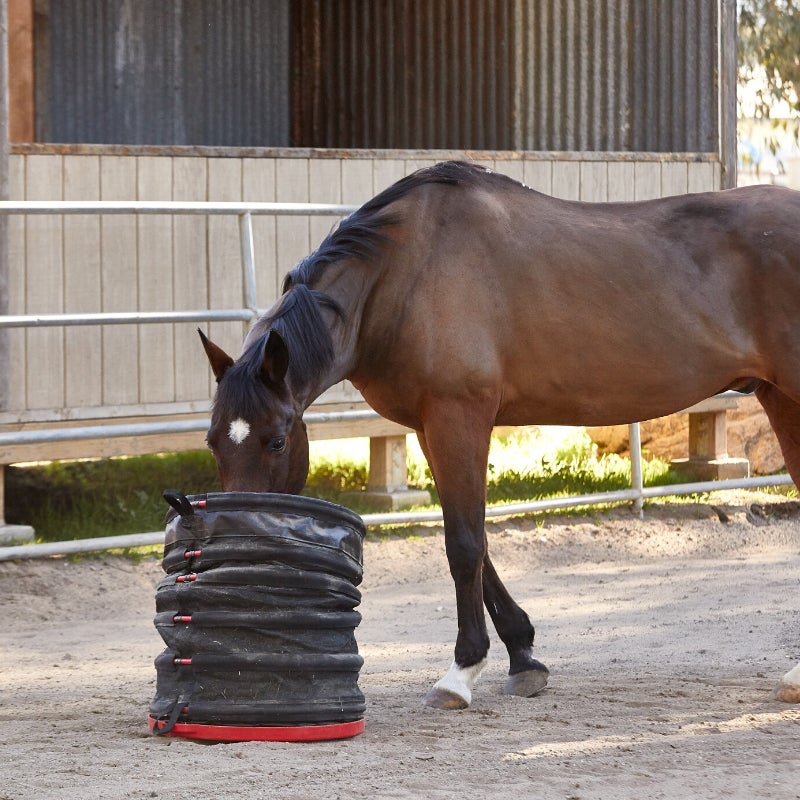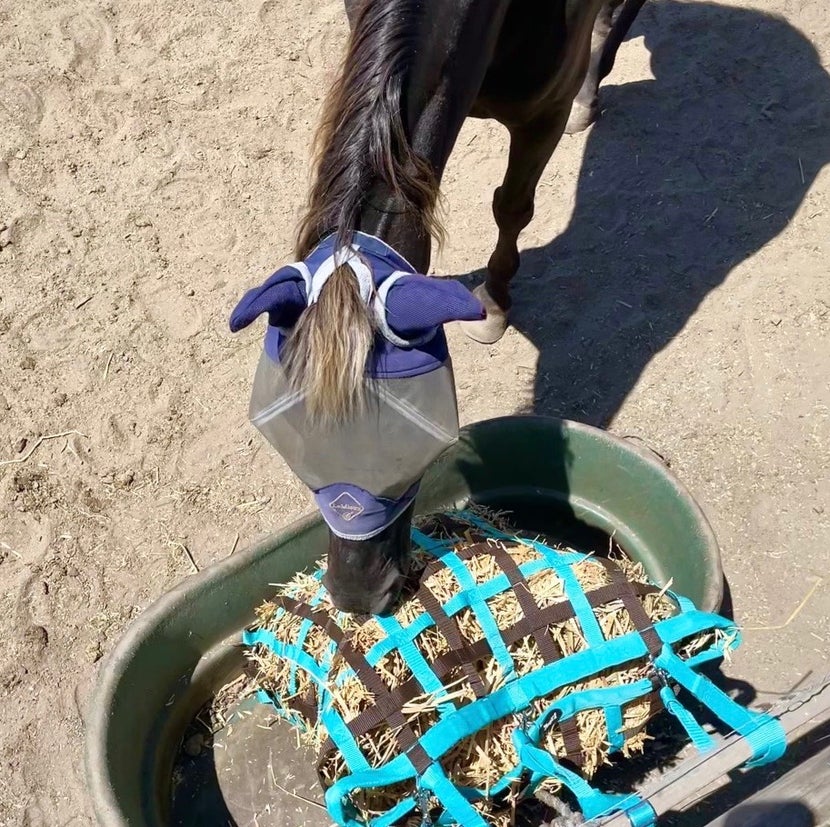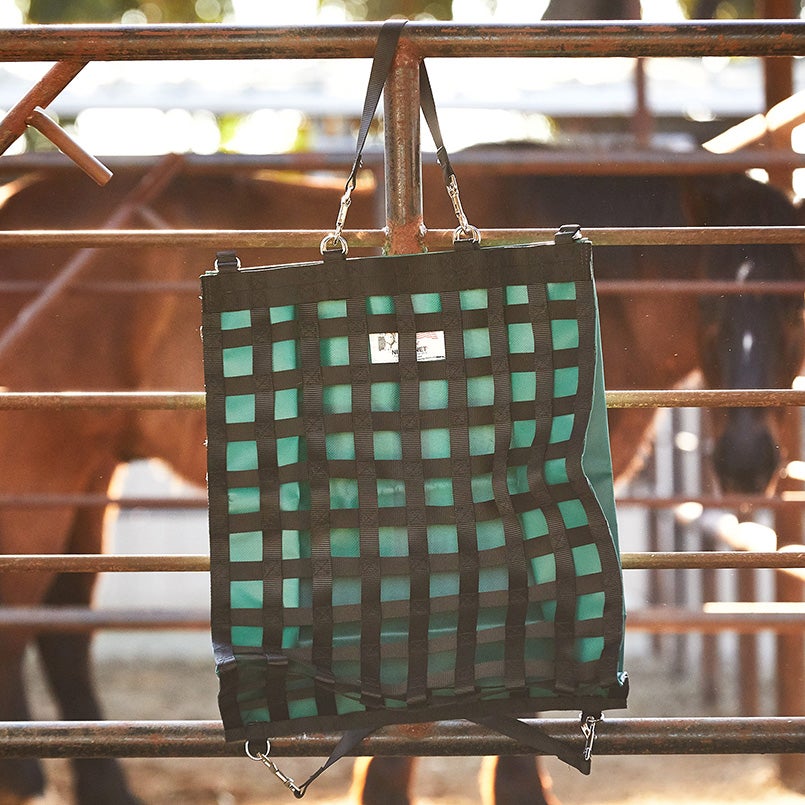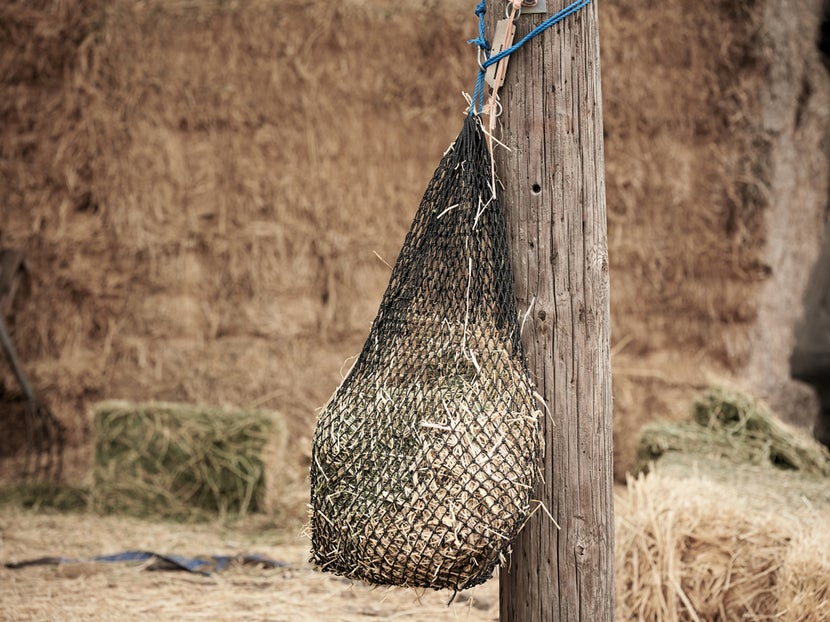Horse Slow Feeder Guide:
How To Use, Safety & Tips
Tips and tricks on how and when to use a slow feeder

Finding the best feeding regimen for your horse can be a challenge. Just like humans, different horses can require different things to thrive; this can be even more difficult if you board your horses. Not every barn owner or manager is open to unique feeding regimens, which can include dietary restrictions, preferences for particular feeds, or specifically timed feedings.
If you're a horse owner or leaser, then you have probably heard about slow feeders at some point in your equestrian journey. Although there are no formal studies on the success of slow feeders, most equestrians are in agreement that they offer more benefit than harm. Slow feeders are designed to mimic a horse's natural habits of eating consistently, instead of limiting them to two or three "meals" throughout the day. One of the many benefits of a feeding regimen that feels more natural to your horse is reduced anxiety.
However, before you introduce a slow feeder, ask yourself: Does my horse even need a slow feeder? Does a slow feeder make sense with my barn, paddock, or pasture setup? If you do choose to get a slow feeder for your horse, there can be safety concerns and doubts about how to use it correctly. We will be addressing these points and more in this article!
If you've already done your research on slow feeders and are ready to make a purchase, check out our guide on The Best Slow Feeders for Horses to help you find the perfect one for you and your favorite equine.
The Benefits of Slow Feeders for Horses
A slow feeder is designed to imitate a horse's natural 24/7 grazing behavior with free-choice foraging when access to fresh grass isn't available. Slow feeders are wonderful tools to balance calorie intake when your hay does not quite meet your horse's nutritional needs. According to the Journal of Equine Veterinary Science, increasing chewing time through slow feeding helps with improving behavioral responses, lowering ulcer risk, and managing hormones. If your horse is already getting its proper calorie intake and nutritional needs met through your current feeding program, we do not suggest changing the system (especially if your vet or equine nutritionist approves)!
For easy keepers or overweight horses, slow feeding helps regulate insulin and metabolism fluctuations that contribute to putting on pounds. Slow feeding improves digestion and the absorption of calories and nutrients for underweight horses as well. This feeding method can also be a great option for horses that eat their hay down quickly and then exhibit negative behaviors from boredom.
The main purpose of slow feeders is to increase chewing time while controlling calorie intake with your horse's self-regulation. When used appropriately, horses that are transitioned to free-fed forage through slow feeding can eat more and maintain or lose weight at the same time. As equestrians all know, a well-balanced nutrition plan is essential to your horse's life!
How to Introduce a Slow Feeder
to Your Horse
When introducing slow feeding to your horse, we highly recommend going slow! It is best to avoid adding any food-related stress to your horse's life by going about feed changes without proper research, planning, or execution. To reiterate, the overall goal is to provide your horse's daily hay requirement through 24/7 forage access. Your horse needs to go through a learning process to know that there will always be hay available through slow feeding. Patience and consistency will help maintain your horse's mental and metabolic health.
- Be sure to provide loose hay for your horse upon initial introduction. Feed your normal portion, but give 3/4 of the hay loose and the rest in a slow feeder that has larger holes (we recommend starting with a slow feeder with 1.75" - 3" holes, depending on equine age).
- Continue to provide a portion of loose hay for about two weeks to a month. During this time, start cutting back on the amount of loose hay given while adding more hay to the slow feeder as a secondary food option. Having an additional slow feeder with smaller holes (1" - 1.5") will help overindulgent horses as they learn.
- At some point, your horse should start to prefer eating from the slow feeder. Switch to exclusively feeding your horse from a smaller-sized slow feeder or two. Some horses may refuse to eat if they become especially frustrated by a too-small hole size, so monitor their eating behaviors.
- Once your horse is slow feeding without any food-related stress, you can transition to an even smaller hole size that holds a larger portion of hay. Most horses do well long-term on 1" - 1.5" sized holes.
- Your horse needs to learn self-regulation through this gradual transition to be less prone to overeating in the beginning, which can lead to colic. Having multiple slow feeders in several locations with various hole sizes for different hay types promotes your horse's movement as well.
If you are feeding tightly flaked hay, such as alfalfa, you can pull it apart when putting it in your slow feeder to help reduce frustration. Slow feeding low to the ground or from the ground induces a more relaxed, natural state; if on the ground, protect your slow feeder from excess dirt or damage with a bin (especially if your horse is shod). If your horse is still eating too quickly or gaining too much weight, cut back on the hay portion you are feeding and restrict their intake with a smaller hole size.
It is easier to purchase several slow feeders that hold larger portions of hay (such as a full bale), so you have to refill them less often. Your horse will eventually realize they will consistently have food access.
Factor in Your Hay
There are important factors to keep in mind when choosing a slow feeder; it is not a one-size-fits-all solution! Material, hole size, hay type, and horse age or size all influence your equine's comfort or irritability during their hay consumption. If your horse is destroying your slow feeder or eating too quickly (continuing weight issues), it is time to reexamine your slow feeder and hay combination. Please refer to the handy chart below for a general guideline:
| Hole Size | Hay Type | Horse Age/Size |
| 0.5" - 1" | Grass, Chopped, Medium to Coarse Hay | Minis, Ponies, Donkeys, Mules, & Indulgent Horses |
| 1.5" | Longer Grass, Chopped, Alfalfa, Bermuda, Fine Hay | Young & Most Horses (Used to Hay Nets/Bags) |
| 1.75" - 2" | Grass, Timothy, Alfalfa, Forage, Thick to Coarse Hay | Anxious & Older Horses, Drafts, Warmbloods |
| 3" - 4" | Long Stemmed, Straw, All Hays | Special Needs/Senior Horses, Cattle |
Finding the right feeder and hay combo can take trial and error with different hole sizes. Horses have different learning speeds, personalities, and patience when it comes to slow feeding. Be prepared to invest time, money, and effort into helping your horse accept the concept, especially if you are introducing slow feeding to them.
Horse Slow Feeding Tips & Tricks
Feeding Tips
- Have Multiple Slow Feeders: We strongly suggest having at least two slow feeders per horse, even if stalled together. Having multiple slow feeder locations offers a more steady flow of forage and encourages your horse's natural tendency to move around to graze. Always be sure your slow feeders are secure.
- Select the Right Hole Size: Selecting your slow feeder hole size can be tricky. One factor is the size of the horse's muzzle and whether they can use their lips and teeth to get hay out of the hole openings. Typically, it comes down to how quickly the horse tends to eat. Horses that inhale their hay will be likely to do well with smaller openings long-term. It's not a bad practice to have a variety of hole sizes on hand, so you can swap different feeders per season depending on how your horse carries weight in the colder and hotter months.
- Repurpose Your Training Feeders: You can continue to repurpose your initial slow feeders with larger holes for trailering, showing, or camping; there is no need to toss them once you transition your horse to a smaller hole size! Traveling tends to induce some stress in horses, and providing a slow feeder with larger holes for easier access can alleviate additional stress.
- Add a Digestive Supplement: Because your horse will be consuming more hay than normal with the slow feeding method, adding a digestive aid will help them more efficiently break down their food and better process the hay nutrients. A digestion or gut health supplement can also help reduce the potential of colic!
Safety Tips
- Material Matters: Avoid metal or steel mesh grates as these can cause dental issues with long-term use. It is better to opt for feeders with softer or flexible constructions.
- Slow Feeder Placement: Be mindful of height placement. Horses are designed to eat off the ground. Long-term feeding with their head elevated can cause physical ramifications and potential respiratory issues.
- Prevent Injuries: Feeders can get caught on shoes and around legs if not secured well, which can cause life-threatening injuries. When using hay net styles, run the extra string through the bottom of the net and use a clip to attach it back to the net itself. Doing so helps keep your feeder elevated off of the ground after becoming empty.
- Maintenance is Key: Check slow feeders daily for damages. Rips and tears can create areas that can entangle a horse in dangerous ways. Make a habit of inspecting them every time you feed to ensure they can be repaired or replaced before causing an issue!
Will My Boarding Barn Allow a Slow Feeder?
It's a good idea to speak with your barn management before buying a slow feeder. While it is up to the horse owner on what kind of feeding regime they feel is right for their horse, barn management can refuse to allow them; this is typically not done to be difficult, but barn staff can work long and hard hours for not a lot of money. If every horse in the barn has a special feeding program, it can easily add hours to the workday. Talking to your barn management about the type of slow feeder you want to use and whether it would be feasible is considerate, and it may warm them up to the idea! If considering a pasture slow feeder for a shared field, be prepared for rejection unless all horse owners involved agree to use slow feeders.
Listed below are a few options to consider for happy staff at your barn:
- Purchase more than one of the same slow feeders and offer to regularly prep them, so the staff can simply deliver them like normal hay feedings.
- Be open to exploring a different slow feeder type if management thinks your pick will be too much extra work for the staff.
- Be willing to consider paying an additional fee for added work for the staff.
When boarding, the barn staff helps make our horse's world go 'round! We recommend including them in your slow feeder decision, so they can offer their insight while feeling appreciated. It's a triple win when all participating parties can feel happy and cared for.
Our Favorite Slow Feeders

The Tough 1 Large Slow Feed Double-Sided Web Hay Net is a favorite at Riding Warehouse. Constructed from 1" wide webbing with 2" hole openings on both the front and back, this hay net holds up well for introducing slow feeding to your equine. It is easy to load several flakes of hay at a time, and there are straps with snaps on both the top and bottom for better security. Plus, who doesn't love a pop of color? For our full review, explore our Slow Feeder Review & Experience article.
If you are looking for more slow feeder options, check out our Best Slow Feeder Buying Guide. Or, we invite you to shop the staff picks below to find the right one for you and your horse!
Shop the Best Slow Feeders:
Closing Thoughts
Introducing a slow feeder can greatly improve your horse's health by promoting a more natural grazing pattern. We all wish we could provide our equines with ample amounts of land covered in healthy grass to graze on, but that just isn't the reality for most horse owners. Some horses have injuries and other health issues that make this impossible, but their digestive system still functions best on continuous grazing. Slow feeders can improve behavioral responses, prevent and manage issues, as well as promote a healthy weight. This is made possible by simply giving your horse the ability to eat the way nature intended, with a little help from the technology of slow feeders!
If you are considering trying slow feeding, we strongly encourage speaking to your vet or equine nutritionist before changing your horse's current feeding program. For more information on slow feeders, please reach out to our helpful customer service at info@ridingwarehouse.com or 1-800-620-9145. Happy riding!









